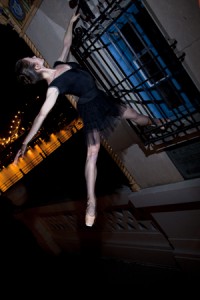
by Emily Kate Long
Most dancers have had to take a second job to pay the bills at some point in their career. In high school I cleaned houses and babysat, but throughout my professional life I’ve been lucky enough to have dance-related second jobs: as a teacher, guest artist, and summer chaperone.

This summer I tried my hand waiting tables at a casual mom-and-pop restaurant in my neighborhood. After one day shadowing another server, my manager threw me out on the floor still wet behind the ears. It was chaotic and overwhelming and tons of fun…and, I’ve realized, not all that different from performing. I’ll admit, though, that I’m a lot less klutzy when my workday is choreographed!
Working for a small business has the same close-knit feel of dancing in a small company. Everyone has to be really invested in the work for our service to be good so the business can grow. We do the legwork and we see the immediate payoff of a happy table or a transformative moment onstage.
The ebb and flow of serving during a rush feels like getting ready for a performance. You sweat through class every day, you rehearse all your roles, you preset costumes and shoes and headpieces for quick changes, and as soon as that music starts, you get onstage and don’t look back.

I can’t say brewing sixteen gallons of iced tea and rolling dozens of sets of silverware each morning is as satisfying as class and rehearsal, but I can appreciate the importance of being well equipped to confidently serve a full house, whether they’re sitting in red velvet seats or at red-checkered tables.
When I work with other servers during a rush, we divide and conquer to get all the prep work, side work, and cut work done while still making sure our guests are happy. Usually it’s as simple as checking in with one another about the status of each table and whether or not there are cups in the dishwasher. Since we share our tips, we all benefit most when everybody’s on top of things.
That teamwork mentality comes easily to dancers. We know that the show is best when each performer takes responsibility for him- or herself and takes joy in the collective effort of putting work onstage. Being accountable to a group is a really powerful motivator, and shared success is a truly special thing.
 Of course, bad reviews and cranky customers are both inevitable and necessary. They’re a way to either toughen up against unfounded censure or learn something valuable from constructive criticism. Some people are just impossible to please, and for those few snarky ones, it really isn’t worth trying.
Of course, bad reviews and cranky customers are both inevitable and necessary. They’re a way to either toughen up against unfounded censure or learn something valuable from constructive criticism. Some people are just impossible to please, and for those few snarky ones, it really isn’t worth trying.
Splitting up a full tip jar at the end of a shift is great—for the personal satisfaction of knowing we provided good service, and because everybody gets to go home to lights on and food in the fridge. But it doesn’t even come close to the reward of performing: that somebody in the audience might feel or see or think something new as a direct result of what happens onstage. I’d fold all the napkins in the world for that privilege!

Assistant Editor Emily Kate Long began her dance education in South Bend, Indiana, with Kimmary Williams and Jacob Rice, and graduated in 2007 from Pittsburgh Ballet Theatre School’s Schenley Program. She has spent summers studying at Ballet Chicago, Pittsburgh Youth Ballet, Pittsburgh Ballet Theatre School, Miami City Ballet, and Saratoga Summer Dance Intensive/Vail Valley Dance Intensive, where she served as Program Assistant. Ms Long attended Milwaukee Ballet School’s Summer Intensive on scholarship before being invited to join Milwaukee Ballet II in 2007.
Ms Long has been a member of Ballet Quad Cities since 2009. She has danced featured roles in Deanna Carter’s Ash to Glass and Dracula, participated in the company’s 2010 tour to New York City, and most recently performed principal roles in Courtney Lyon’s Sleeping Beauty, The Nutcracker, and Cinderella. She is also on the faculty of Ballet Quad Cities School of Dance, where she teaches ballet, pointe, and repertoire classes.




